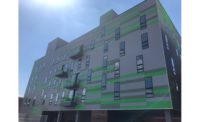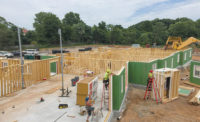Founded in 1924, the Curtis Institute of Music is a full-scholarship music school located on Philadelphia’s historic Rittenhouse Square. Its new 105,000-square footeducation and residence building, named for H. F. “Gerry” and Marguerite Lenfest, opened in September 2011 on time for the start of the academic year and under its $50 million budget.
Lenfest Hall doubles the size of Curtis and expands its campus along Locust Street. New state-of-the-art facilities include: the 3,200-square foot Gould Rehearsal Hall, 32 additional practice and performance studios, an orchestra library, an orchestral collection of over 200 stringed instruments, and for the first time, student residences and dining facilities – all within close proximity to existing facilities on Rittenhouse Square.
“This is transformational for Curtis,” says Curtis Board Chairman and building namesake Gerry Lenfest, at the building’s grand opening. “Our goals go beyond achieving musical virtuosity. We hope the hall will become an incubator for new ideas. Students will learn to collaborate in new ways as they think about attracting and engaging new audiences. They will have the benefit of 21st-century technology as they develop the skills essential for success in an evolving musical environment.”
Its design involved the input of several community groups and the review and approval of Philadelphia’s Historical Commission. The building’s massing and façade designs respect the historic streetscape while signifying Curtis’ bold step forward. Two historic façades flanking the new structure were retained and integrated into the new building. The multi-purpose facility uses acoustical construction techniques, green design principles, and a concrete structural system to create a dynamic and acoustically superior living-learning environment.
ACOUSTICS INFLUENCE
|
Lenfest Hall Project Team |
|
Owner: Curtis Institute of Music, Philadelphia Architect: Venturi, Scott Brown and Associates Inc., Philadelphia Structural Engineer: Keast & Hood Co., Philadelphia and Washington, DC General Contractor/Construction Manager: INTECH Construction Inc., Philadelphia Real Estate Development Manager: Razak Company Civil Engineer: Stantec MEP Engineer, IT/Security Consultant: Marvin Waxman Consulting Engineers, Inc. a subsidiary of Urban Engineers, Inc. Acoustic Consultant: Kirkegaard Associates Lighting Consultant: Grenald Waldren Associates Preservation Consultant: Noble Preservation Systems, Inc. LEED Consultant: Re:Vision |
While the new building will shape generations of Curtis students, acoustics shaped the design of Lenfest Hall. Architect and Associate Seth Cohen, LEED AP, of Venturi, Scott Brown and Associates Inc. explained that music spaces are designed for flexible use with movable acoustic panels and integrated audio-visual systems. Public spaces, such as the dining hall and meeting rooms, are acoustically designed and equipped to support multiple activities, including impromptu performances, lectures, video conferencing, and movies.
Successful collaboration between Curtis, the design team, and construction manager INTECH contributed to acoustic success.
“One of our primary challenges was the advanced level of coordination required among all disciplines,” says Cohen. “We established a hierarchy of acoustic separations, from the rehearsal hall and performing spaces to the residential suites.”
Structural design was a critical first step. The nine-story building utilizes cast-in-place, reinforced concrete construction and box-in-box design to acoustically isolate practice and performance spaces. Keast & Hood co. structural engineer and Principal Constantine Doukakis, PE, led the structural design team.
“In Gould Hall, the finished floor and wall systems, and the concrete deck above, are isolated from adjacent structure using neoprene pads,” Doukakis explains.
The roof over the three-story Gould Hall consists of reinforced concrete slabs spanning between 60-inch deep cast-in-place beams.
“The isolation of the beams and structural slabs prevents structural-borne vibrations from the surrounding building from penetrating the rehearsal space,” Doukakis adds.
BUILDING INGREDIENTS
The building bears on a 3-foot thick concrete mat foundation that incorporates top and bottom layers of steel reinforcing bars and welded wire fabric over the top layer to control localized shrinkage and provide a working surface for the cement finishers during the 1,300-cubic yard mat pour. The lateral force resisting system uses 14- and 16-inch thick concrete shear walls in both directions. A seismic joint separates the shear walls and adjoining concrete frame from the neighboring eight-inch thick brick masonry party walls to the east and west. Special break-away assemblages located within the seismic joint brace the party walls, but are designed to shear at high seismic loading so that Lenfest Hall does not impart lateral loading onto adjacent buildings.
The floor systems consist of two-way flat plate construction with minimal drop panels, which enable consistent acoustic seals between interior walls and the structural slab. The exterior façade of the dormitory tower features prefabricated panels that bear on the edge of the floor slabs. Post-tensioning at the edge of the slabs reduced vertical deflection.
Interior partitions and finishes enhance the acoustic value of the structural system. In Gould Hall, two 8-inch solid CMU walls with air space between provide added sound control. Teaching and practice areas include wall assemblies ranging from a combination of CMU and multi-layered drywall to three to five layers of drywall sandwiching double studs.
All floors in music spaces are “floating” using an assembly of neoprene pads, insulation, sub-floor, and finish flooring. Resiliently hung drywall barrier ceilings were installed above acoustic ceilings. These systems minimize sound and vibration transfer into the space, from above or below, and help isolate sound from mechanical systems. Slightly convex glass fiber reinforced gypsum acoustic reflectors in Gould Hall, positioned at a height of 25 feet, help disperse sound evenly.
WALL TREATMENTS FOR ACOUSTICS
Wall treatments contribute to acoustic control. Motorized acoustic draperies are present on three of four walls in Gould Hall (the fourth wall, comprised of glass, features both solar and blackout curtains). The acoustic draperies can be opened or closed depending on the musical intent of the performance. Open curtains result in a livelier sound. Closed curtains soften the sound. The flexibility enables practice for a full orchestra, ensembles of various sizes, or vocal performances to each obtain an appropriate sound quality in the large space.
Many other rooms incorporate acoustic flexibility with movable sound absorptive panels. Wall track systems allow the fabric panels to be moved, rotated, or otherwise adjusted to achieve desired sound quality. Larger practice spaces and teaching studios have movable panels on all four walls, while smaller rooms include two walls of drywall and two with fabric panels, with the idea that each room has both a “hard” and a “soft” side to play into.
Materials in the rehearsal hall include maple floor chosen for its durability and light reflective quality. A pale natural finish reflects natural light from the window wall to brighten the room. Cherry wainscoting around the perimeter is reminiscent of the rich wood tones of the Curtis Institute’s other buildings and the wood color of the Curtis president’s prized viola. Contemporary detailing lends both a modern touch and further acoustic control; a three-degree cant to the wainscoting directs sound slightly upward into the space.
Like many of the building’s components, custom design was required for the exterior windows in music spaces. Two independent, double-glazed assemblies created with Wausau windows are separated by metal-faced sound absorptive panels. A triple window assembly is used for the percussion studio.
Mechanical systems throughout Lenfest Hall are also acoustically treated. Every pipe, conduit, and duct is hung on springs engineered to the weight of each component.
Lenfest Hall serves its campus community with exceptional amenities and acoustics, while contributing to sensitive urban planning and long-term sustainability.
Philadelphia’s Historic Commission permitted “demolition in the public interest” of the rears of two existing four-story townhouses flanking the property, but mandated that their historic façades be fully restored and incorporated into the new building. The retained façades bookend the contemporary façade and help integrate Lenfest Hall with its historic neighborhood context.
Incorporating the façades was no small feat. Structural steel towers were erected within the houses to brace the façades during demolition and erection of the new concrete frame. Bearing the towers on the sidewalk outside the building was not an option due to a subway tunnel adjacent to the site. The new concrete structure was poured around the steel towers and the masonry façades were tied back to the new floor slabs at each story. Once the façades were secure, the temporary towers were disassembled and floor penetrations infilled by installing reinforcing steel with dowel bar anchors about the perimeter of the individual openings.
LEED PENDING
LEED Gold certification is pending for Lenfest Hall. In addition to sustainable construction methods and efficient building systems, the fifth floor terrace and dormitory tower incorporate green roofs. Additional LEED points were achieved by using a 40 percent by weight of ground-granulated blast furnace slag (GGBFS) for all of the structural concrete and 50 percent by weight for the three-foot thick foundation mat.
“Lenfest Hall bridges Curtis’s past and future. It links the school’s rich history with its 21st-century evolution, offering new spaces for teaching, practicing, and living,” summarizes Venturi, Scott Brown and Associates principal and lead architectural designer, Dan McCoubrey, AIA, LEED AP. W&C







